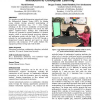Free Online Productivity Tools
i2Speak
i2Symbol
i2OCR
iTex2Img
iWeb2Print
iWeb2Shot
i2Type
iPdf2Split
iPdf2Merge
i2Bopomofo
i2Arabic
i2Style
i2Image
i2PDF
iLatex2Rtf
Sci2ools
CHI
2011
ACM
2011
ACM
The mathematical imagery trainer: from embodied interaction to conceptual learning
We introduce an embodied-interaction instructional design, the Mathematical Imagery Trainer (MIT), for helping young students develop grounded understanding of proportional equivalence (e.g., 2/3 = 4/6). Taking advantage of the low-cost availability of hand-motion tracking provided by the Nintendo Wii remote, the MIT applies cognitive-science findings that mathematical concepts are grounded in mental simulation of dynamic imagery, which is acquired through perceiving, planning, and performing actions with the body. We describe our rationale for and implementation of the MIT through a design-based research approach and report on clinical interviews with twenty-two 4th –6th grade students who engaged in problem-solving tasks with the MIT. Author Keywords Educational technology, mathematics education, embodied cognition, Wii remote, design-based research. ACM Classification Keywords H.5.2. [Information Interfaces]: User Interfaces—input devices and strategies; user-centered design. G...
| Added | 25 Aug 2011 |
| Updated | 25 Aug 2011 |
| Type | Journal |
| Year | 2011 |
| Where | CHI |
| Authors | Mark Howison, Dragan Trninic, Daniel Reinholz, Dor Abrahamson |
Comments (0)

